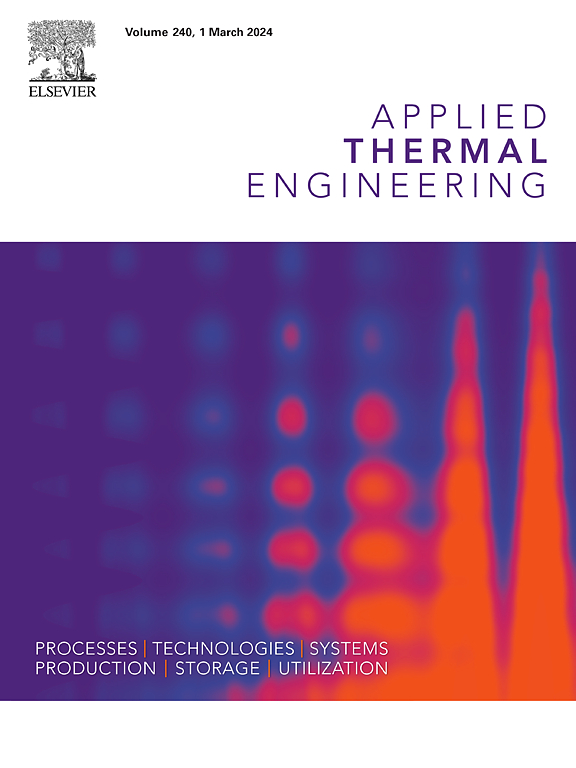受机器学习启发的核流沸腾状态下单气泡动态参数研究
IF 6.1
2区 工程技术
Q2 ENERGY & FUELS
引用次数: 0
摘要
有核沸腾的传热性能与蒸汽气泡的离去动力学相互关联,这也是传热分区方案和气泡生长模型的基础。由于沸腾实验具有快速瞬变和多次气泡胀破循环的特点,因此需要对大量数据进行分析,以确定气泡动态参数,进而确定沸腾传热速率。传统的人工处理这种时间和空间分辨实验数据的方法既耗时又容易出错。在这些局限性的背景下,机器学习算法在使整个过程自动化和精确化方面的重要性就凸显出来了,因为它们最大限度地减少了人工干预的需要。本研究探索了机器学习技术在量化核流动沸腾过程中气泡离开特征和传热分区方面的潜力。在不同过冷度(ΔTsub = 2、5 和 8 K)和流速(Re = 2400 和 3600)条件下,在垂直通道中进行了基于水的实验。采用掩膜 R-CNN 机器学习(ML)模型来评估气泡动态参数的时间变化和离去特征。通过 ML 生成的掩码检索到的气泡离去特征以及相应的蒸发和对流传热速率,显示出与散装流体过冷度和流速的强烈相关性。传热分区分析表明,在沸腾传热的总体传热速率中,蒸发和冷凝成分之间存在相互影响的竞争关系。这些发现证明了 ML 技术在优化沸腾现象热性能方面的潜力,对一系列关键工程应用具有重要意义。本文章由计算机程序翻译,如有差异,请以英文原文为准。
Machine learning-inspired study of dynamical parameters of single vapor bubble under nucleate flow boiling regime
Heat transfer performance of nucleate boiling is interlinked with the departure dynamics of vapor bubbles, which also serves as the basis for heat transfer partitioning schemes and bubble growth models. Given the fast transients and multiple bubble ebullition cycles, boiling experiments lead to voluminous data that are to be analysed for determining the bubble dynamic parameters, and subsequently, the boiling heat transfer rates. Conventional approach of manual handling of such temporal and spatially-resolved experimental data is inherently time-consuming and error-prone. In the backdrop of these limitations, importance of machine learning algorithms gets highlighted in making the entire process automated and accurate as they minimize the need of any human intervention. The present work explores the potential of machine learning techniques towards quantifying the bubble departure characteristics and heat transfer partitioning during nucleate flow boiling. Water-based experiments have been conducted in a vertical channel under varying subcooling levels (ΔTsub = 2, 5, and 8 K) and flow rates (Re = 2400, and 3600). Mask R-CNN machine learning (ML) model is employed to evaluate the temporal variations of dynamical parameters of vapor bubbles and departure characteristics. The bubble departure characteristics as well as the corresponding evaporative and convective heat transfer rates, as retrieved through ML-generated masks, showed a strong dependence on the level of bulk fluid subcooling and flow rates. Heat transfer partitioning analysis revealed a competing interplay between the evaporative and condensation components of overall boiling heat transfer rates. These findings demonstrate the potential of ML techniques towards optimizing the thermal performance of boiling phenomena that have significant implications in a range of critical engineering applications.
求助全文
通过发布文献求助,成功后即可免费获取论文全文。
去求助
来源期刊

Applied Thermal Engineering
工程技术-工程:机械
CiteScore
11.30
自引率
15.60%
发文量
1474
审稿时长
57 days
期刊介绍:
Applied Thermal Engineering disseminates novel research related to the design, development and demonstration of components, devices, equipment, technologies and systems involving thermal processes for the production, storage, utilization and conservation of energy, with a focus on engineering application.
The journal publishes high-quality and high-impact Original Research Articles, Review Articles, Short Communications and Letters to the Editor on cutting-edge innovations in research, and recent advances or issues of interest to the thermal engineering community.
 求助内容:
求助内容: 应助结果提醒方式:
应助结果提醒方式:


